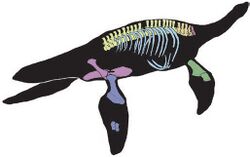Biology:Plesiopharos
| Plesiopharos | |
|---|---|

| |
| Fossils | |
| Scientific classification | |
| Missing taxonomy template (fix): | Plesiosauroidea/? |
| Genus: | †Plesiopharos Puértolas-Pascual et al., 2021 |
| Species: | †P. moelensis
|
| Binomial name | |
| †Plesiopharos moelensis Puértolas-Pascual et al., 2021
| |
Plesiopharos (derived from the Greek words πλησίος (plesios), "close" and φάρος (pharos), "lighthouse", because its holotype was found in the vicinity of a lighthouse + [from São Pedro de] Moel) is an extinct plesiosaur that lived in what is now Portugal, in the Early Jurassic. Specifically, it was discovered in São Pedro de Moel, Marinha Grande, from which the type species' binomial name, Plesiopharos moelensis, derives from.
At the time of its publication (2021), this plesiosaur was the most complete and oldest known from the Iberian Peninsula.[1]
Discovery
The fossils were found by two collectors, António Silva (1999) and Vítor Teixeira (2012) and who donated them to the Lourinhã Museum in 2017 and were completely prepared in the Dino Parque laboratory.[1]
Description
The Plesiopharos holotype (ML 2302) consists of parts of the fin of the arm (humerus and radius), of the right leg (femur), pelvic girdle (pubis, ilium and ischium) of the thorax (vertebrae, ribs and gastralia) and of the neck (cervical vertebra).[1] It would be an adult animal with an estimated size between 2.5 and 2.8 m.[citation needed]
Classification
Plesiopharos moelensis is classified as a basal member of Plesiosauroidea.[1]
Paleoenvironment
Plesiopharos moelensis was discovered at Praia da Concha, São Pedro de Moel, Marinha Grande, in layers that belong to the Coimbra Formation, which date to the Sinemurian.[2][3]
References
- ↑ 1.0 1.1 1.2 1.3 Puértolas-Pascual, Eduardo; Marx, Miguel; Mateus, Octávio; Saleiro, André; Fernandes, Alexandra E.; Marinheiro, João; Tomás, Carla; Mateus, Simão (2021), "A new plesiosaur from the Lower Jurassic of Portugal and the early radiation of Plesiosauroidea", Acta Palaeontologica Polonica 66 (in press), doi:10.4202/app.00815.2020
- ↑ Duarte, L.V., Silva, R., Duarte, C.B., Azerêdo, A.C., and Comas Rengifo, M.J. 2008. Litostratigrafia do Jurássico Inferior da região de S. Pedro de Moel (Bacia Lusitânica, Portugal). In: P.M. Callapez (ed.), A Terra, Conflitos e Ordem. Homenagem ao Professor Ferreira Soares, 175– 185. Museu e Laboratório de Mineralogia e Geologia da Universidade de Coimbra, Coimbra.
- ↑ Duarte, L.V., Comas-Rengifo, M.J., Silva, R.L., Paredes, R., and Goy, A. 2014. Carbon isotope stratigraphy and ammonite biochronostratigraphy across the Sinemurian–Pliensbachian boundary in the western Iberian margin. Bulletin of Geosciences 89: 719–736.
Wikidata ☰ Q107207764 entry
 |



